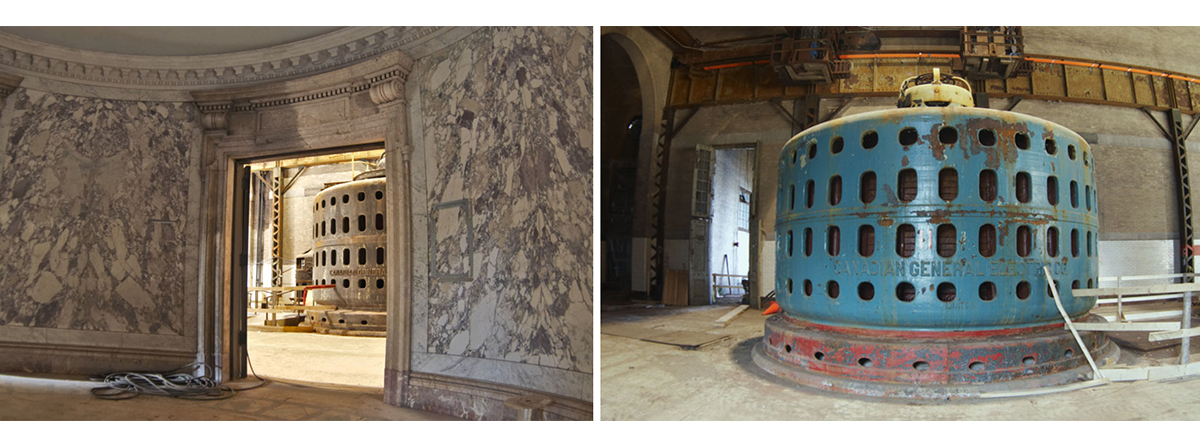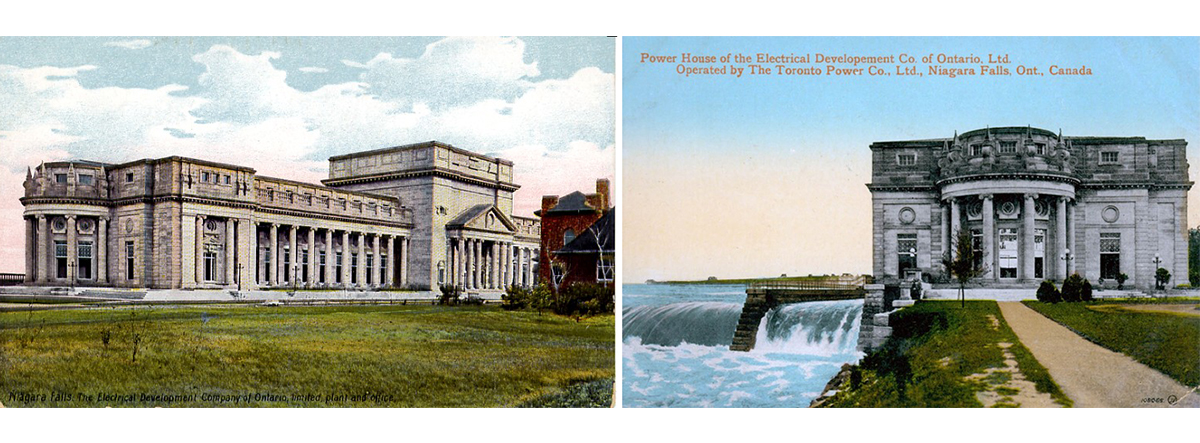Location: Niagara Falls
Date of Completion: 1906
Architect: Edward James Lennox
Nominated by: Wayne Gates, MPP (Niagara Falls)
“The electricity generated by water power is the only thing that is going to keep future generations from freezing. Now we use coal...but there will be a time when there’ll be no more coal to use.”
- Charles Proteus Steinmetz
"Electricity Will Keep the World from Freezing Up," New York Times, November 12, 1911
An industrial powerhouse in palatial clothing, the grandeur of the now-dormant Toronto Power Generating Station speaks to the ambition and wealth behind the first wholly Canadian-owned hydroelectric facility in Niagara Falls—a business venture that would eventually be at the centre of the fight for public utilities.
Powering up Toronto...For A Cost
In the late 1800s, as electricity use continued to proliferate across southern Ontario, harnessing the power of the Niagara River had long been an ambition for the growing Toronto, particularly to its motivated business class who sought to make a profit from this novel technology. By 1896, thanks to technology developed by Nikola Tesla, the first-ever long-distance transmission of Niagara power had been proven by delivering electricity to Buffalo, New York, and a race to control electric generation in Niagara had begun. Starting in 1899, several private syndicates sought privileges from the Niagara Falls Park Commission for the construction of hydroelectric stations including the Electrical Development Company of Ontario.
Owned by three Canadian businessmen, this company would be responsible for the construction of the Toronto Power Generation Station, the first wholly Canadian-owned hydroelectric facility in Niagara Falls. Respectively providing Toronto’s outdoor lighting, indoor lighting, and first electric street railway, billionaire financier Henry Pellatt, manufacturer Frederic Nicholls, and Toronto Transit Commission (TTC) founder William Mackenzie held a monopoly over Toronto’s coal-powered electricity industry. At the same time, while the Electrical Development Company was provided with a contract for the new power station, many municipalities—including Toronto—were denied by the Commission for similar privileges despite numerous bids ensuring early hydroelectric power remained solely in private hands.

Left: The grand entry to the generator hall with beaux-arts detailing. Right: A generator. Images courtesy of the Niagara Falls (Ontario) Public Library.
Designed to provide Toronto with now-defunct 25 cycle power, the Toronto Power Generating Station was equipped with a wheel pit 120-m (400-ft) long and 45-m (150-ft) deep with 11 turbines. Initially, the station could produce more than 8,000,000 watts of electricity; after years of development, it had the capacity to produce over 100,000,000 watts. By November 19, 1906, hydroelectric power reached Toronto and was flowing through the city two days later.
A Grand Style for a Not So Grand Building
Clad in Indiana limestone and flanked on either side by symmetrically laid out Ionic colonnades, the Toronto Power Generating Station was designed to impress. Despite mainly being a warehouse building for the machinery required for power generation, the building’s exterior is reflective of what was then the style of choice for grand civic architecture: the Beaux-Arts style. Emerging from the Ecole des Beaux-Arts in Paris, this classically inspired and often decadent style was frequently applied to significant public buildings such as libraries, train stations, and courthouses. Its application on an industrial site such as this one was unusual, and most likely explained as a response to the uniquely scenic setting of the powerplant, as well as the desire of its owners to project an image of wealth and grandeur.
In fact, the Electrical Development Company of Ontario spared no expense and retained the services of one of Toronto’s most prominent architects, Edward James Lennox, for the design of the station. Lennox designed several of the city’s most notable landmarks, including Old City Hall and the West Wing of the Ontario Legislative Building. He was also the architect behind the over-the-top Casa Loma, a home commissioned by none other than Henry Pellatt.
 Left: Postcard of Northern façade. Images courtesy of the Niagara Falls (Ontario) Public Library.
Left: Postcard of Northern façade. Images courtesy of the Niagara Falls (Ontario) Public Library.
Right: Generator hall. Image courtesy of the Niagara Falls (Ontario) Public Library.
While the grand Beaux-Arts exterior speaks to a sense of civic pride, its lavish construction is also a reminder of the corporate and personal wealth accumulated by the few reaping the benefits of the industrial revolution. This palatial structure built by a private monopoly would also become a symbol of the fight between private and public ownership of electrical utilities, a battle that would eventually lead to the establishment of the Hydro-Electric Power Commission of Ontario (today’s Ontario Hydro) in 1906.
A Sleeping Giant
After being purchased by the Hydro-Electric Power Commission of Ontario in 1922, the Toronto Power Generating Station continued to produce electricity until 1974 when it was decommissioned and replaced with the much larger Sir Adam Beck Generating Stations in Queenston, Ontario.
Today, the station remains largely unused. For a brief time in 1982, it was operated as a museum called the Engineerium that celebrated the development of hydroelectric power. It was designated a National Historic Site in 1983, and ownership was transferred to the Niagara Parks Commission in 2007. The station has been the focus of many assessments to consider possibilities for adaptive reuse, but none of these efforts have produced visible results. However, its potential for a new life has been made particularly evident with the recent revitalization of the neighbouring Canadian Niagara Power Generating Station (also known as the Rankine Generating Station). Built in 1905, this nearby building was converted in 2021 into a new tourist destination and event space to serve the growing needs of Niagara Falls.
.png)
Generator hall. Image courtesy of the Niagara Falls (Ontario) Public Library.
This post forms part of our World Architecture Day Queen’s Park Picks 2021 series in which the OAA asked Ontario’s Members of Provincial Parliament (MPPs) to nominate a prominent building, past or present, in their riding for a chance to learn more about it. Check out the rest of the series to learn more about great buildings across the province!
Additional Resources
Are you interested in learning more about the Toronto Power Generating Station? Check out these additional resources: